Continuing my Paris adventure…
Those of us who have long enjoyed the various Photo Reference Galleries of Harpguitars.net, especially some of the more important and rare historical examples, owe a debt of gratitude to the Musee de la Musique, better known as the musical instrument museum within the Cite de la Musique (City of Music).
They may have been one of the first such institutions to put their collection up on the Internet for reference, and researchers and aficionados have been going ga-ga ever since. Doing a Google search for “musique.jpg” within site: Harpguitars.net, I see that I include 25 specimens from their vast collection (including many true harp guitars). I was now beside myself with excitement to be able to see some of these instruments in person.
I could also learn a bit more about the museum after buying the English version of their new (2009) souvenir book. For example, that the collection began with a newly-created music Conservatoire in 1795…though little survives from that auspicious beginning; due to financial difficulties and lack of interest, by 1816 nearly everything had been sold off or deteriorated, while the harpsichords were used as firewood (can you imagine?!). Conditions improved and acquisitions increased, and by 1864, the first public galleries were opened. The growing museum continued to acquire important collections and specimens, particularly from 1920-1950, and eventually had to find a new, permanent location.
That occurred when the Cite de la Musique was eventually founded, and in 1997, the current museum opened on its campus. What I saw is the result of major renovation begun in 2007 that continues to this day. It is a very modern and increasingly sophisticated presentation dedicated to making the collection as culturally, socially and musically relevant as possible. Of their 6000 instruments, about 1000 are on display. Here are some highlights (in rough order of my meanderings, and based on my own obsessive interests):
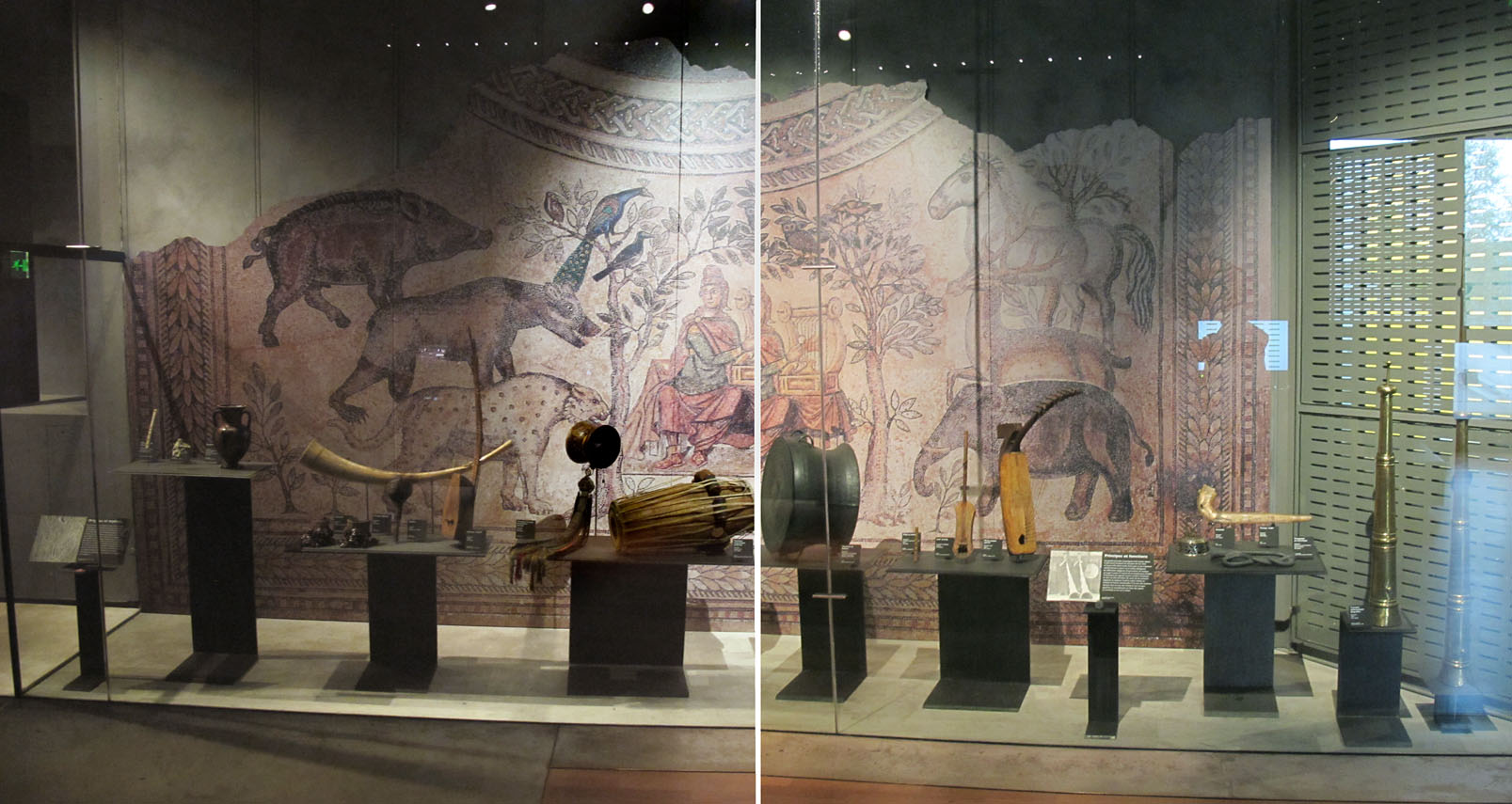
One is first greeted by an introductory exhibit with African and other “primitive” instruments
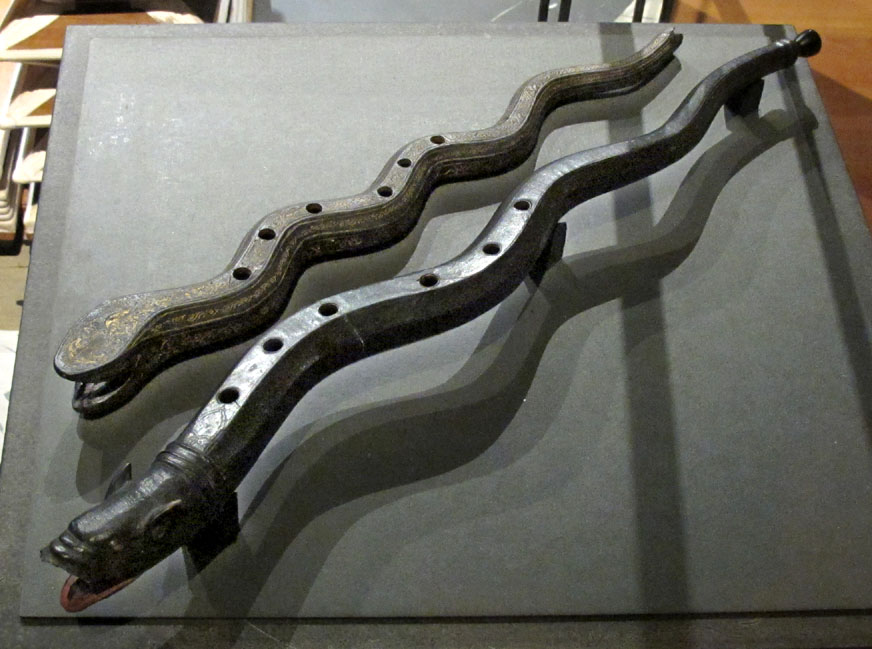
I am always inexorably drawn toward zoomorphic forms in musical instruments, perhaps due to being an ex-zookeeper/herpetoculturist. These are cornets.

Bass cornet with dragon’s head
Incredible keyboards include:
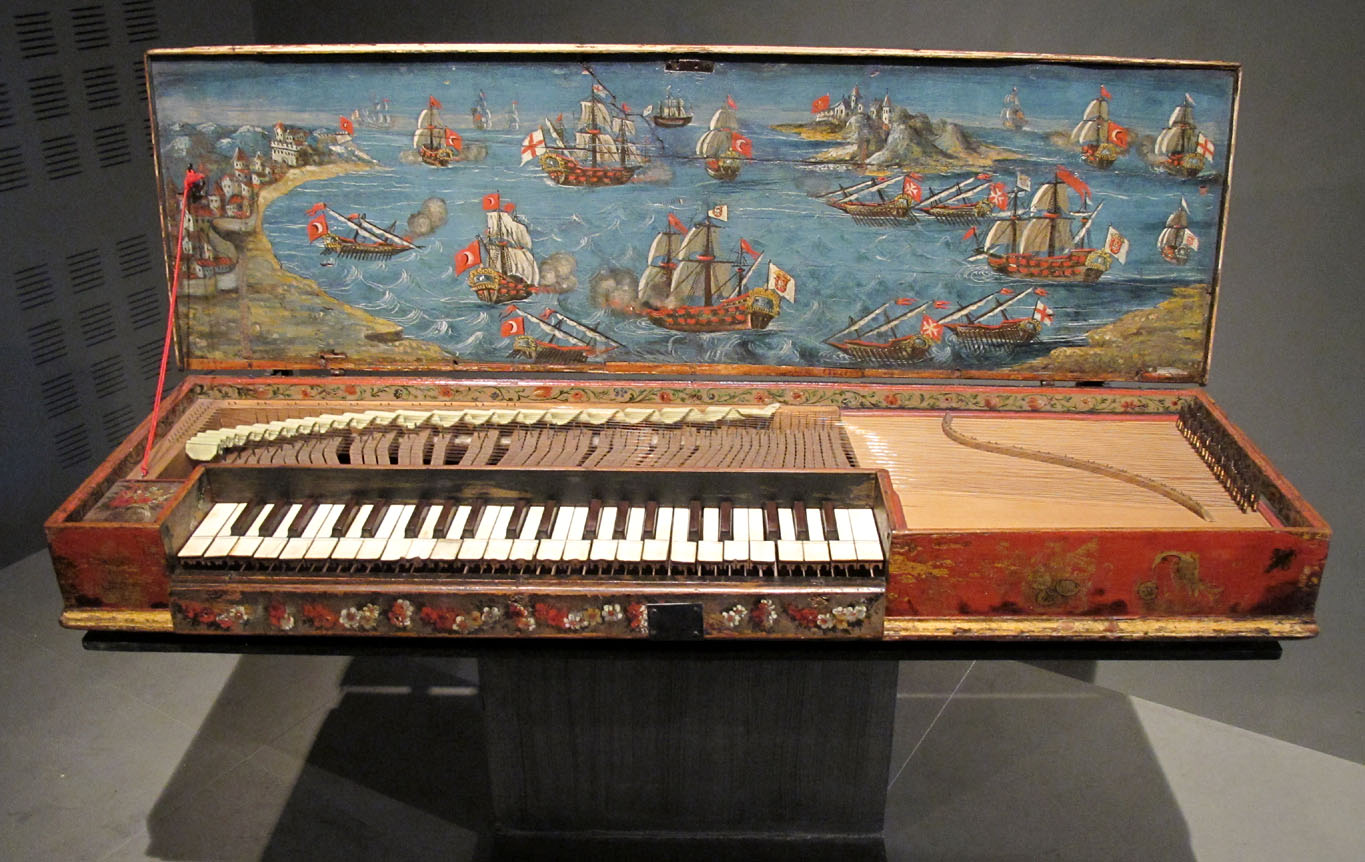
Clavicorde lié dit de ″Lepante″ (anonyme, Italie ?, 16e ?)
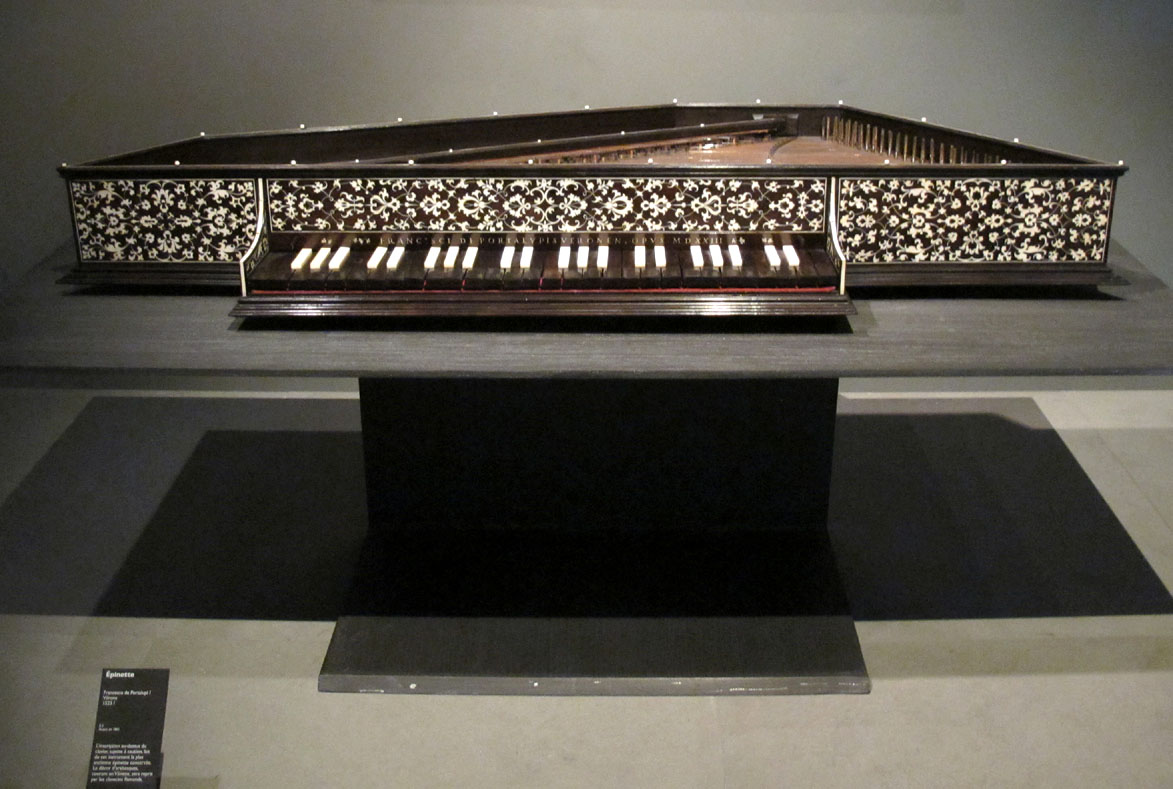
Epinette (Francesco de Portalupi ?, Verone, 1523 ?)
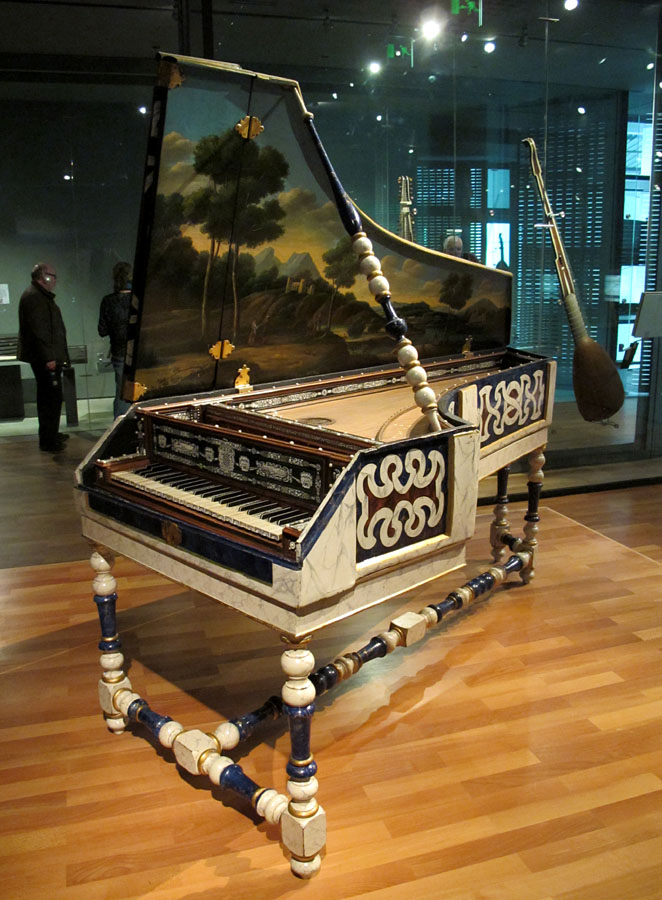
Harpsichord (P. Faby, Bologna, 1677)
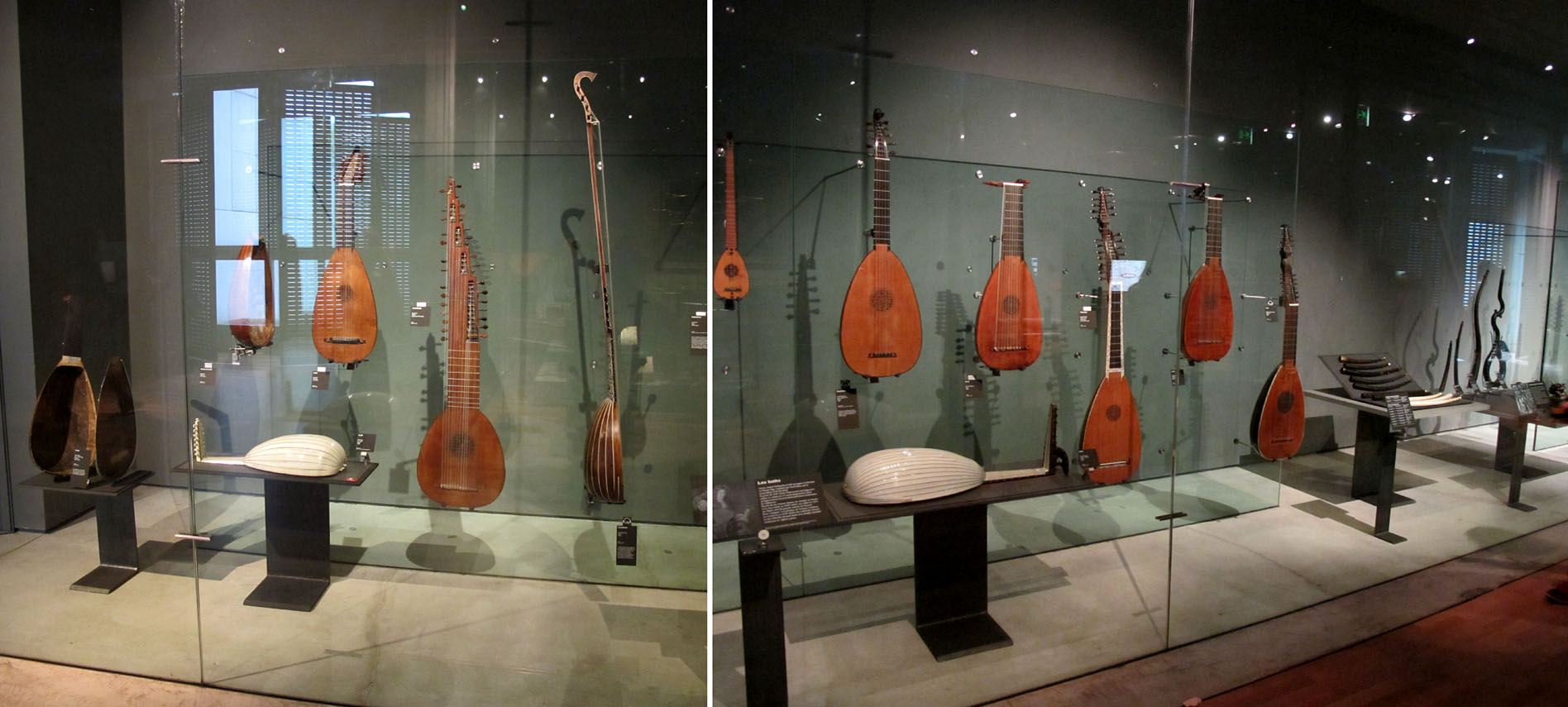
There were lutes and theorboes everywhere, not just in this main case. Note the “stair-step” form.
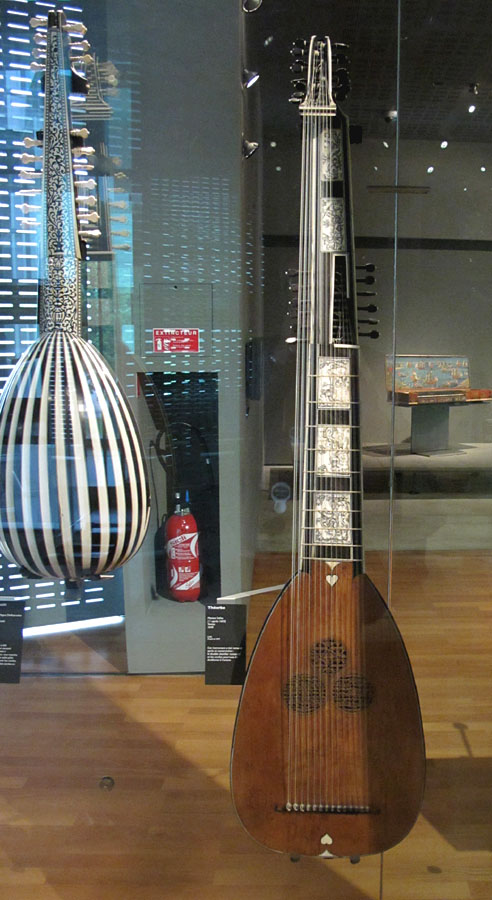
Two of many incredible archlutes
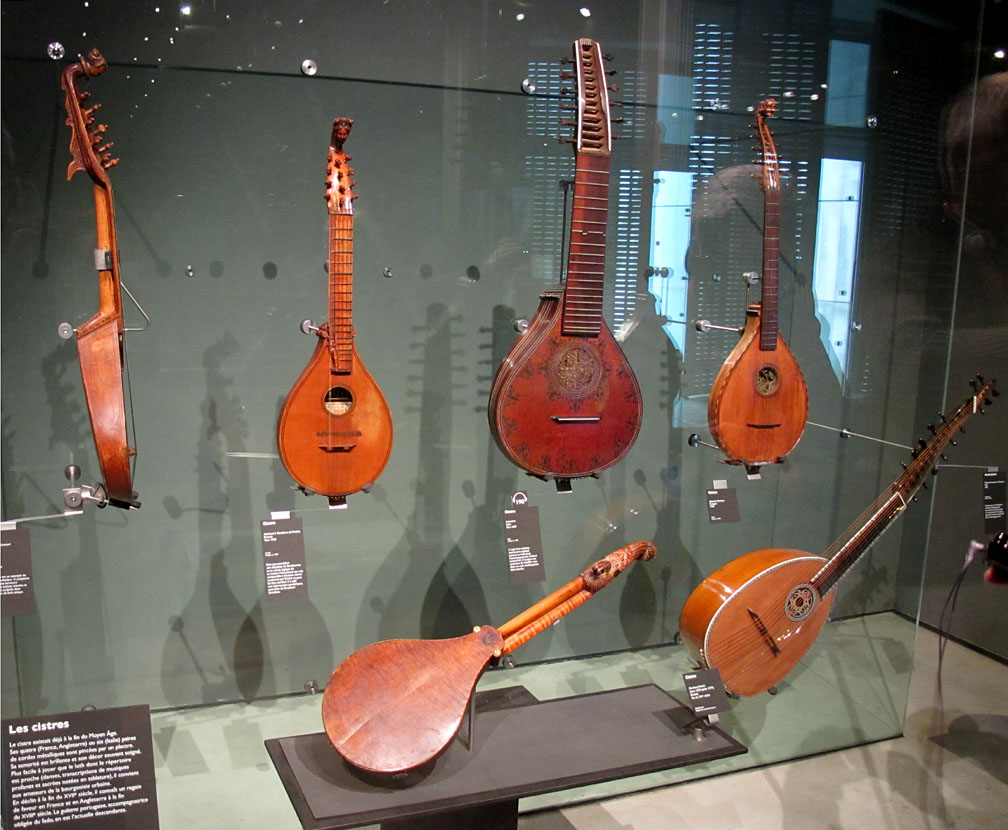
A cittern display
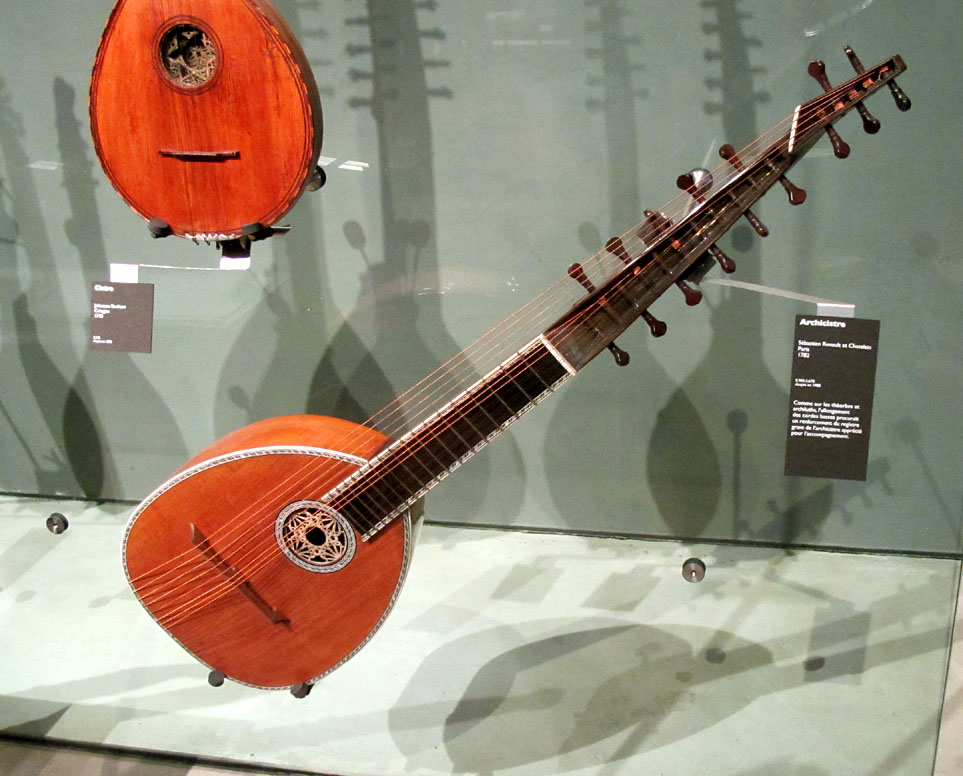
It includes a near-mint Renault & Chatelain arch-cistre…
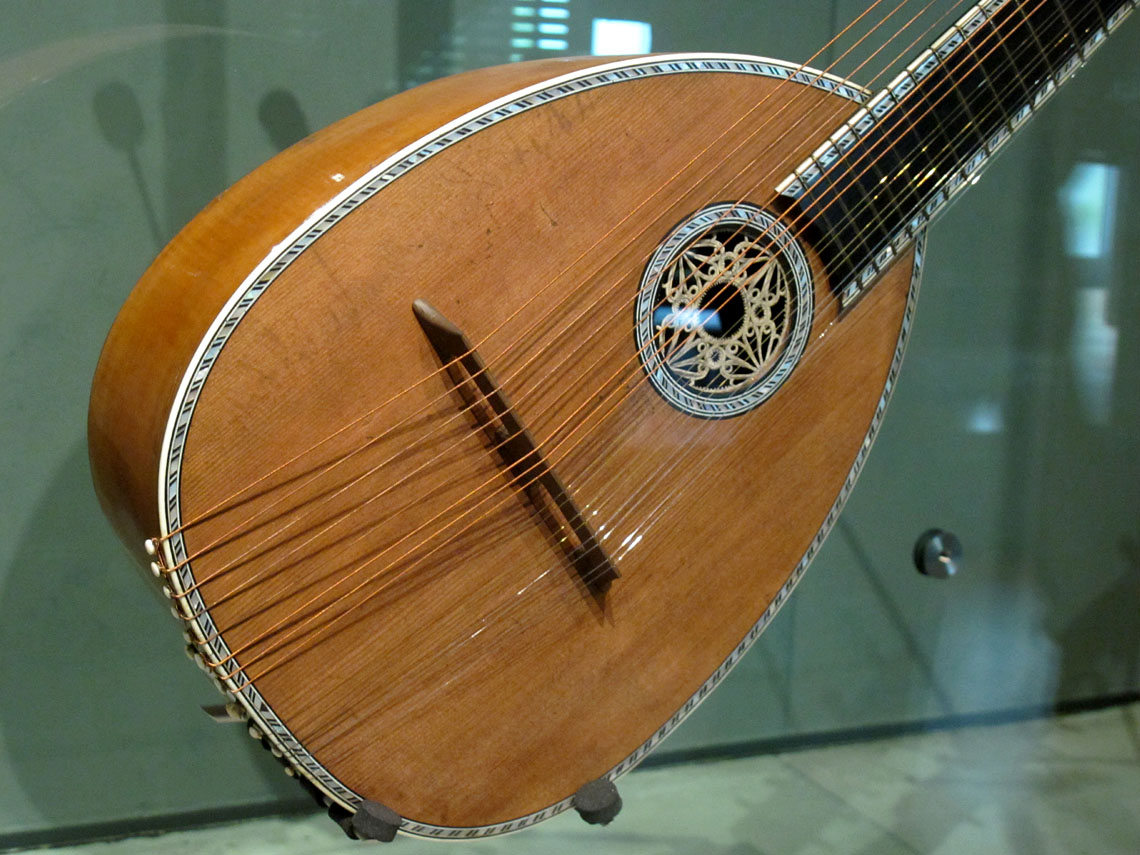
I was interested in the string material, as I now have a simple, lute-back version of this open-A-tuned wire-strung instrument.
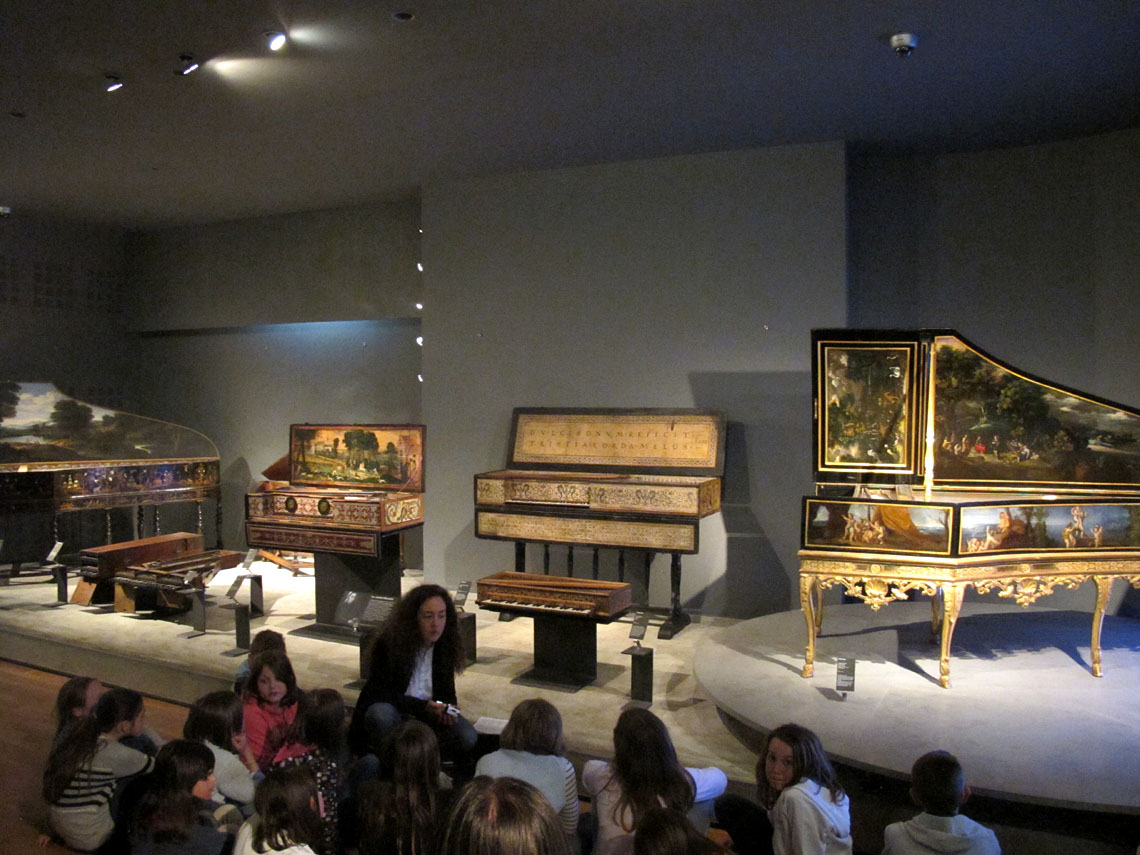
There were multiple school groups on some intense class field trips. All were pretty well-behaved, but not as much as I, who waited patiently for the little rug rats to clear out so I could check out the keyboards they’d commandeered.
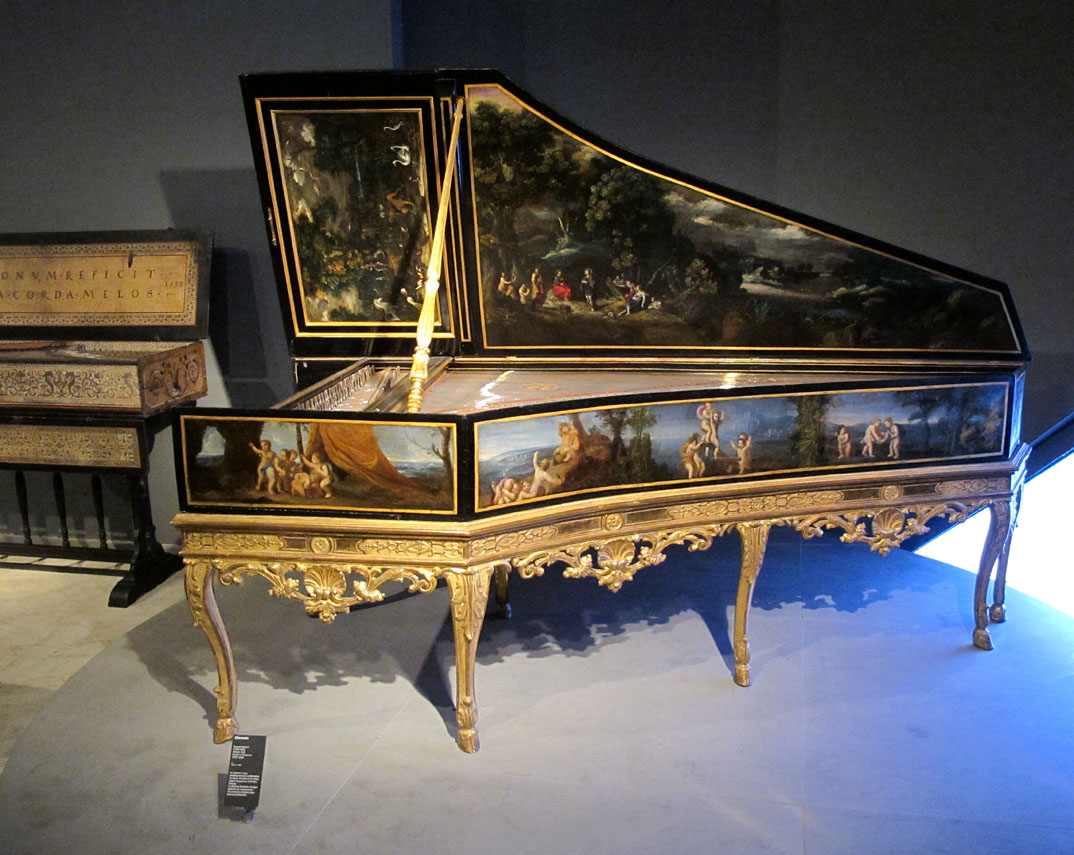
Harpsichord (Ruckers, Anvers, 1612)
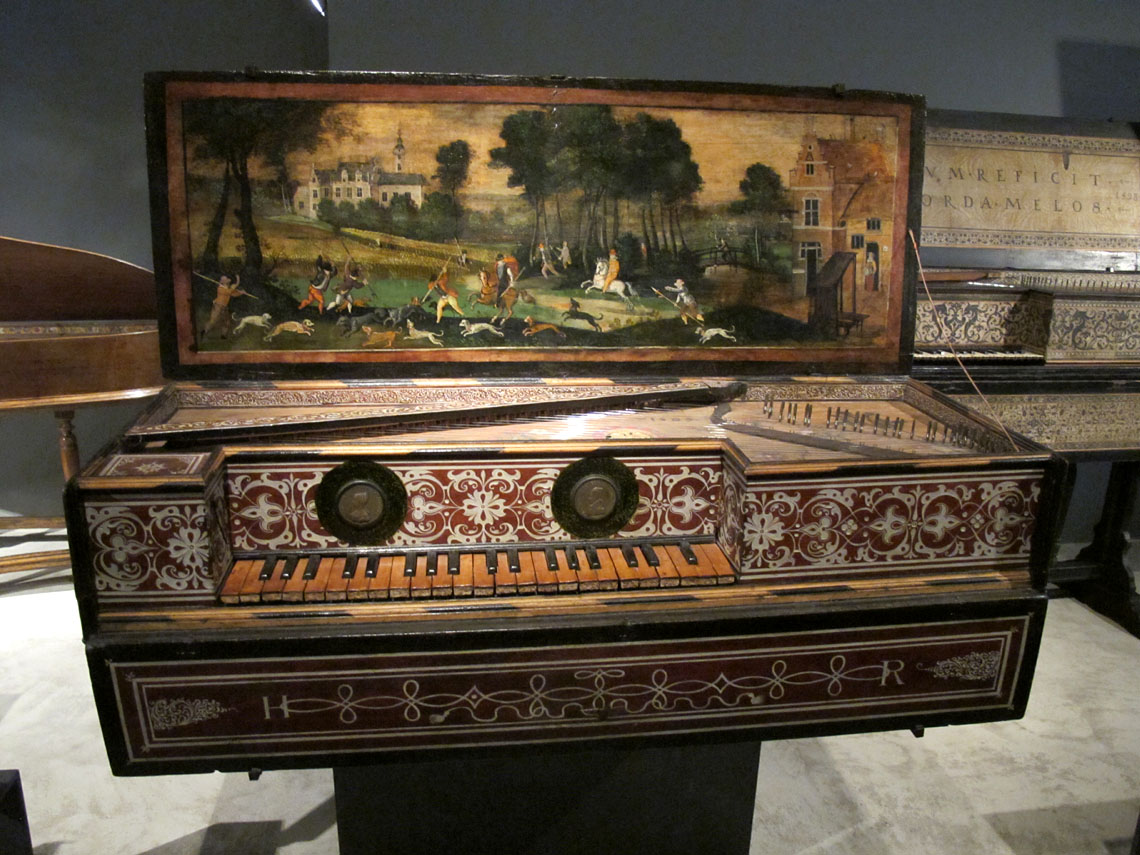
Virginale a la quinte (Hans Ruckers, 1583)
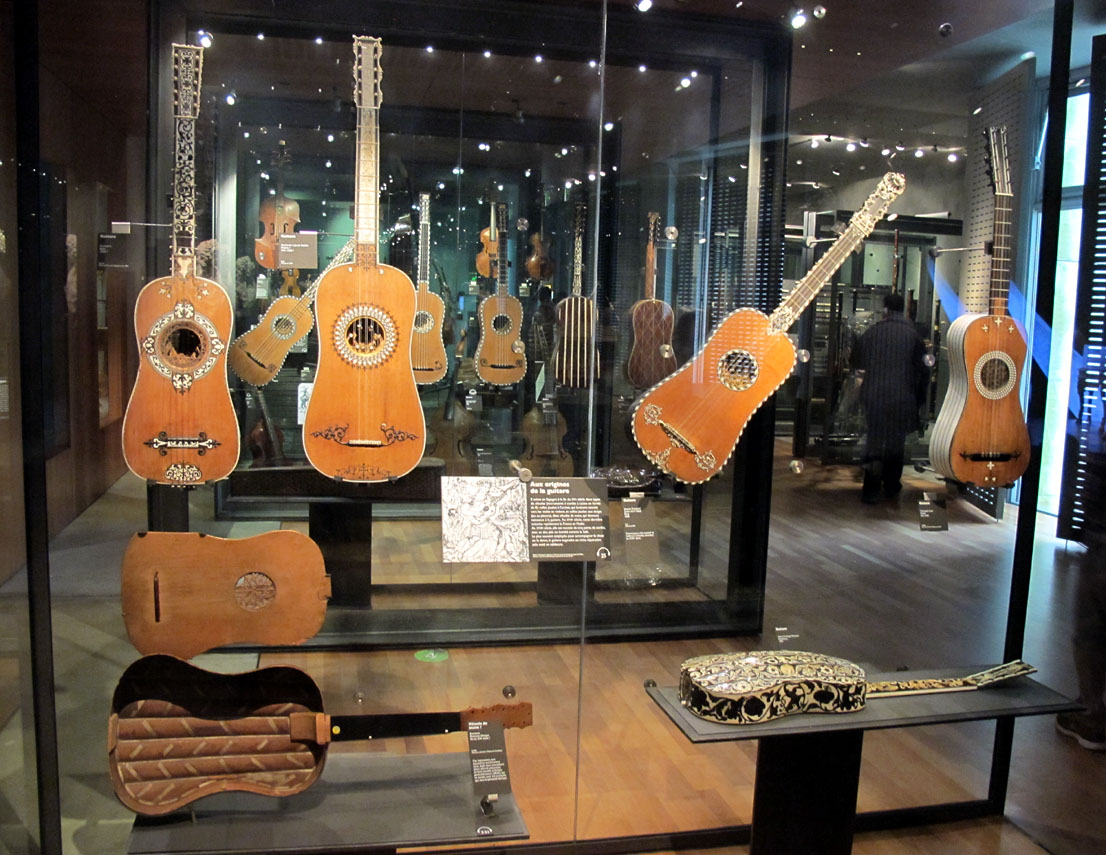
Plenty o’ guitars to keep one occupied and perpetually drooling
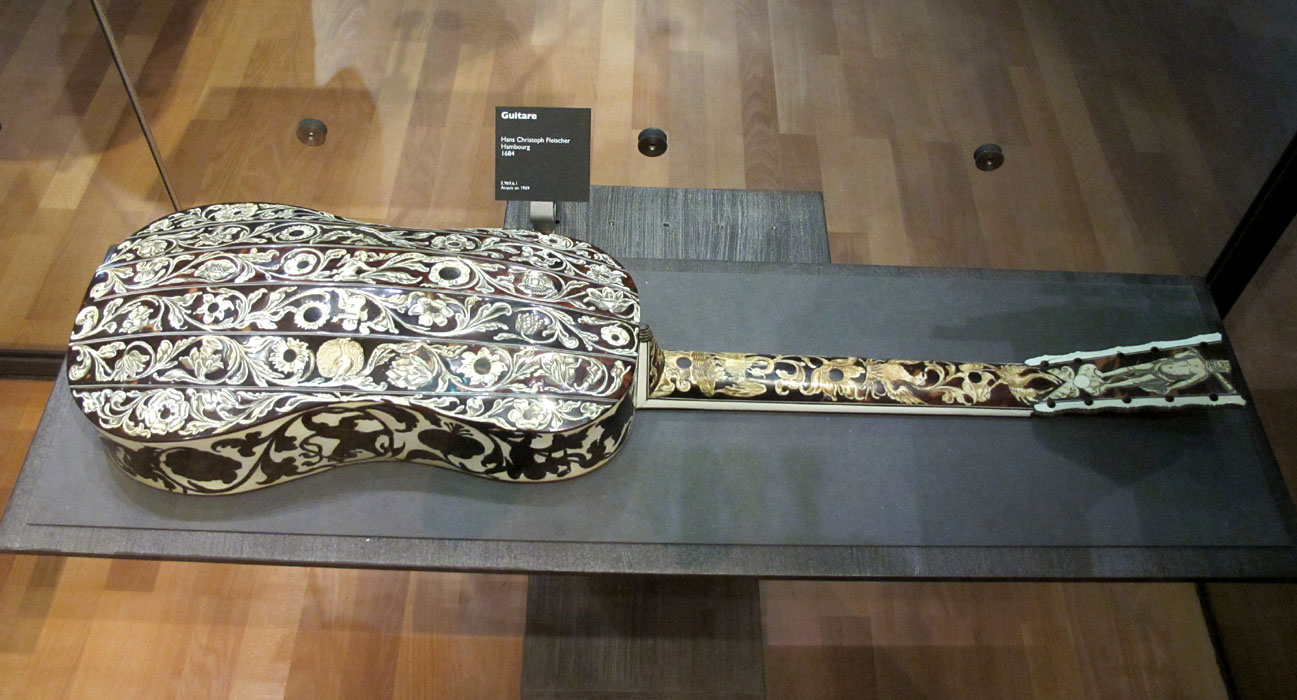
Hans Christoph Fleischer, Hambourg, 1684
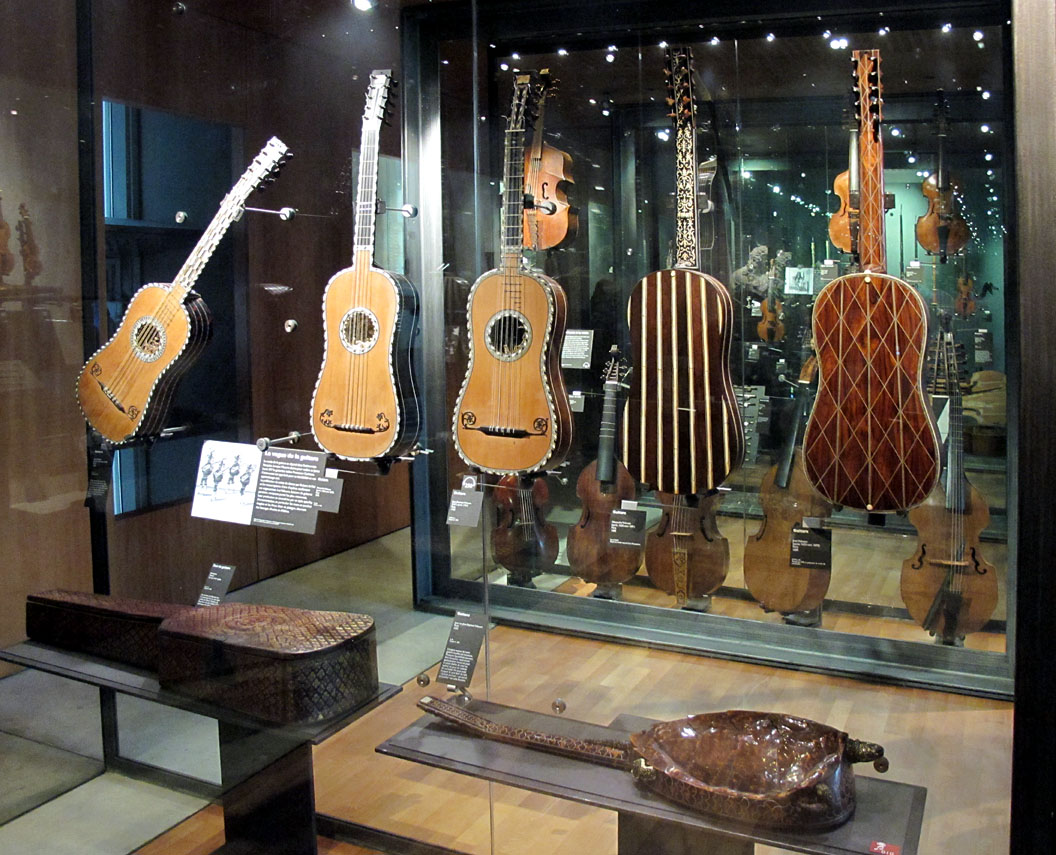
This display contains one of the most outrageous guitars I’ve ever seen
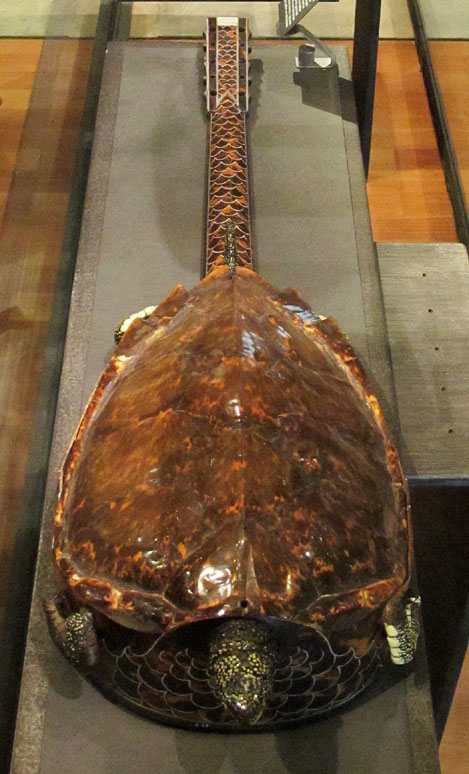
This one creeped even me out a little bit. It’s not the use of an entire, intact shell of a sea turtle for a guitar body (giving true meaning to “tortoiseshell”); after all, antique instruments (and a thousand other vintage objects) are festooned with the now-outlawed material…
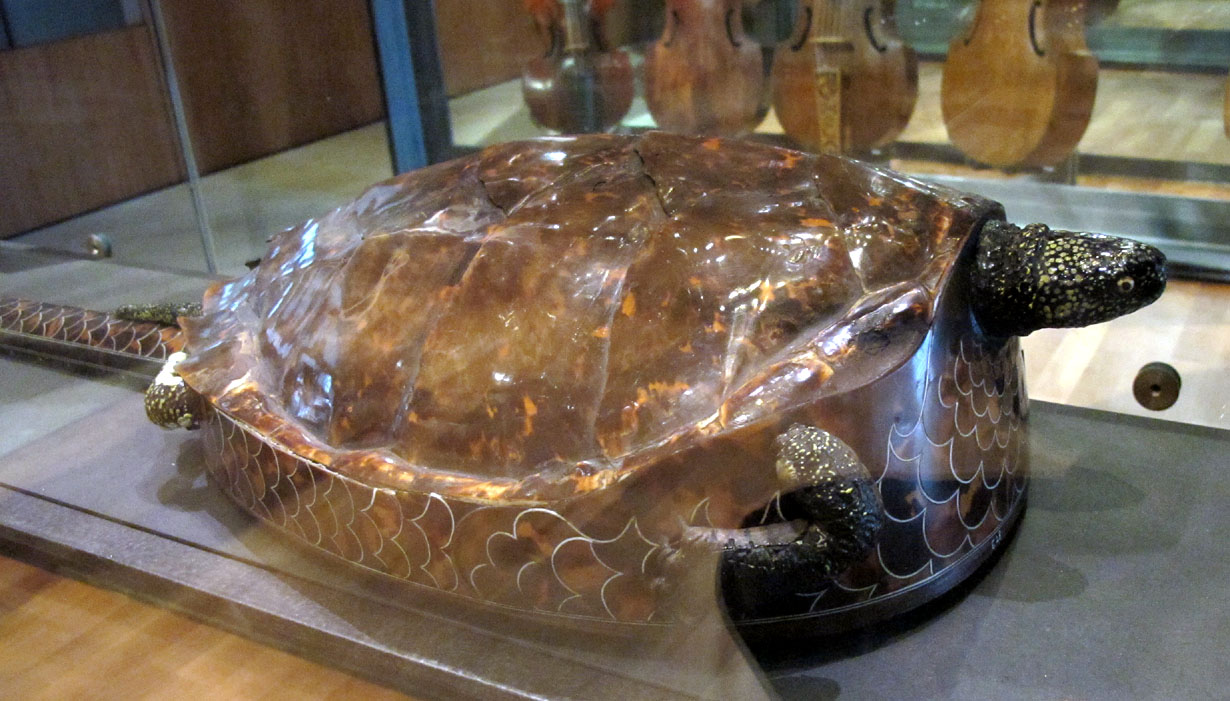
…it’s that Voboam (Paris, 1693) re-created the unfortunate reptile’s head and limbs in beautiful but macabre detail out of other materials (I hope). By the way, neither the signage, the book nor the audio tour gave me the hoped-for details on these instruments; a comprehensive French/English catalog would be welcome!

Assorted mandolin forms

A beautiful, adorable small hurdy-gurdy
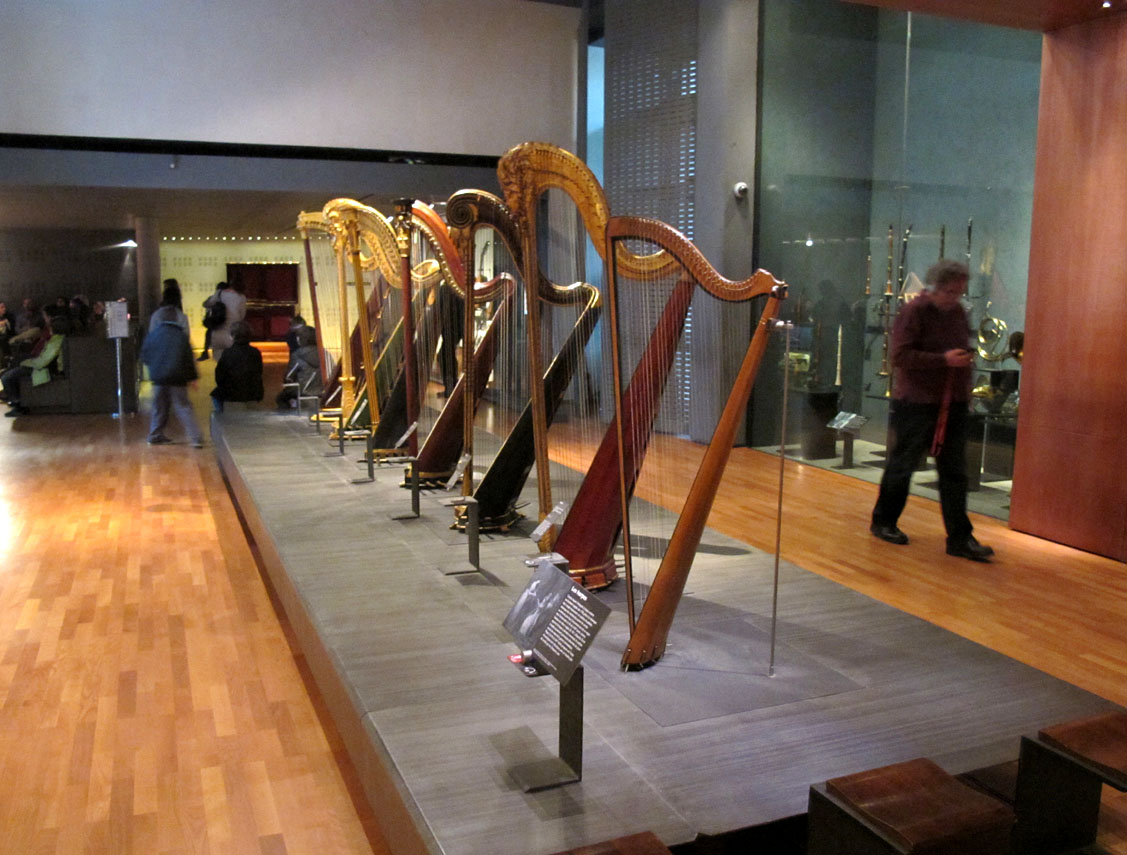
Entering the hallway of harps
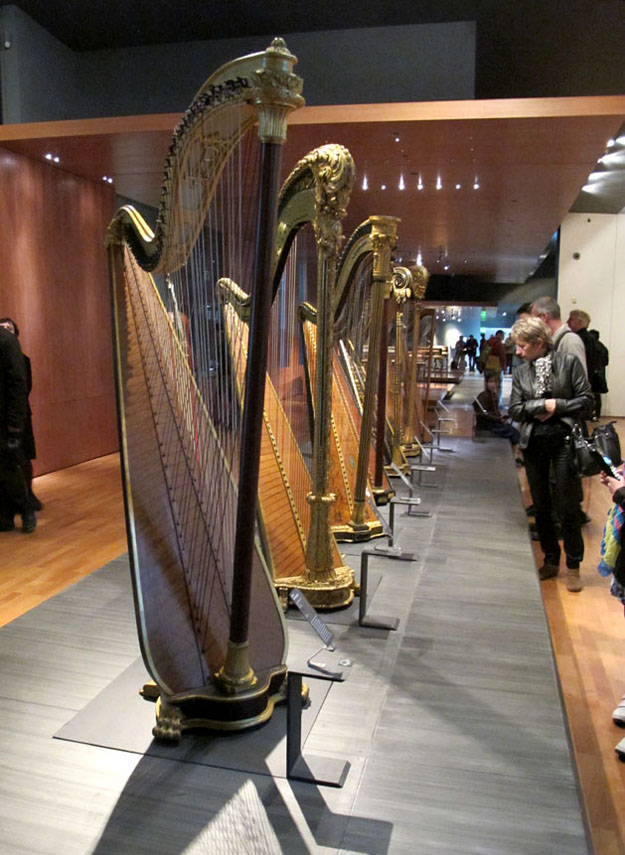
And looking back
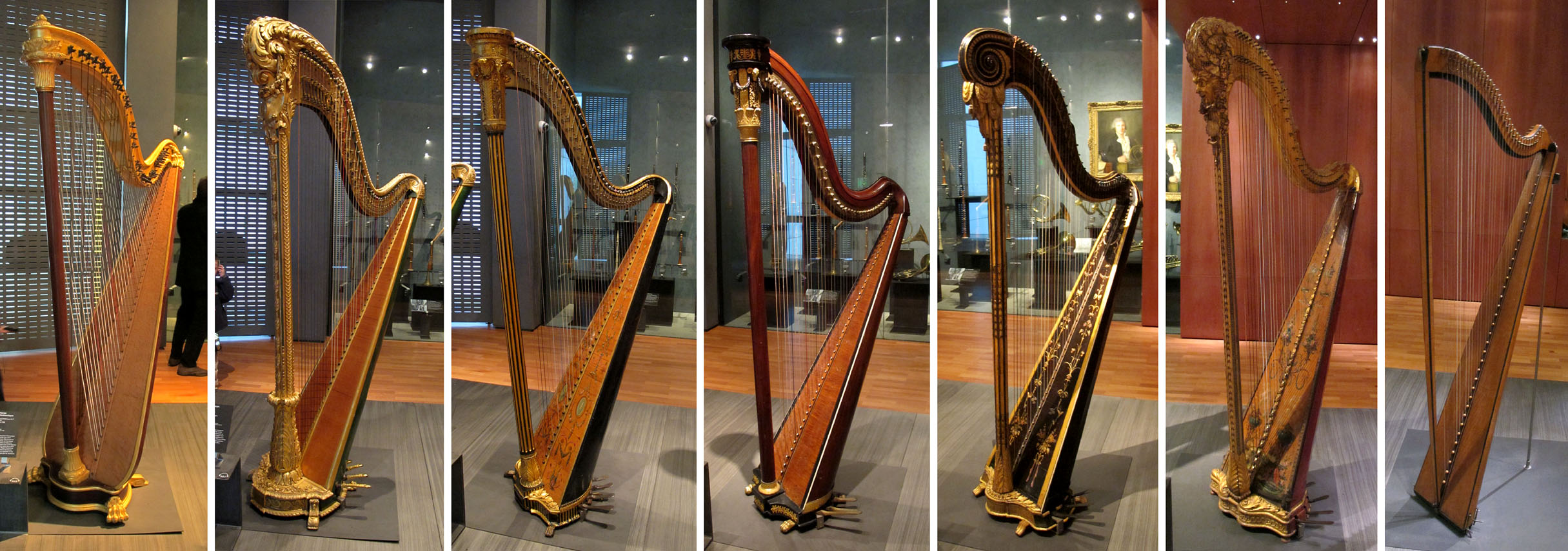
I was able to capture a full shot of each in the line-up…
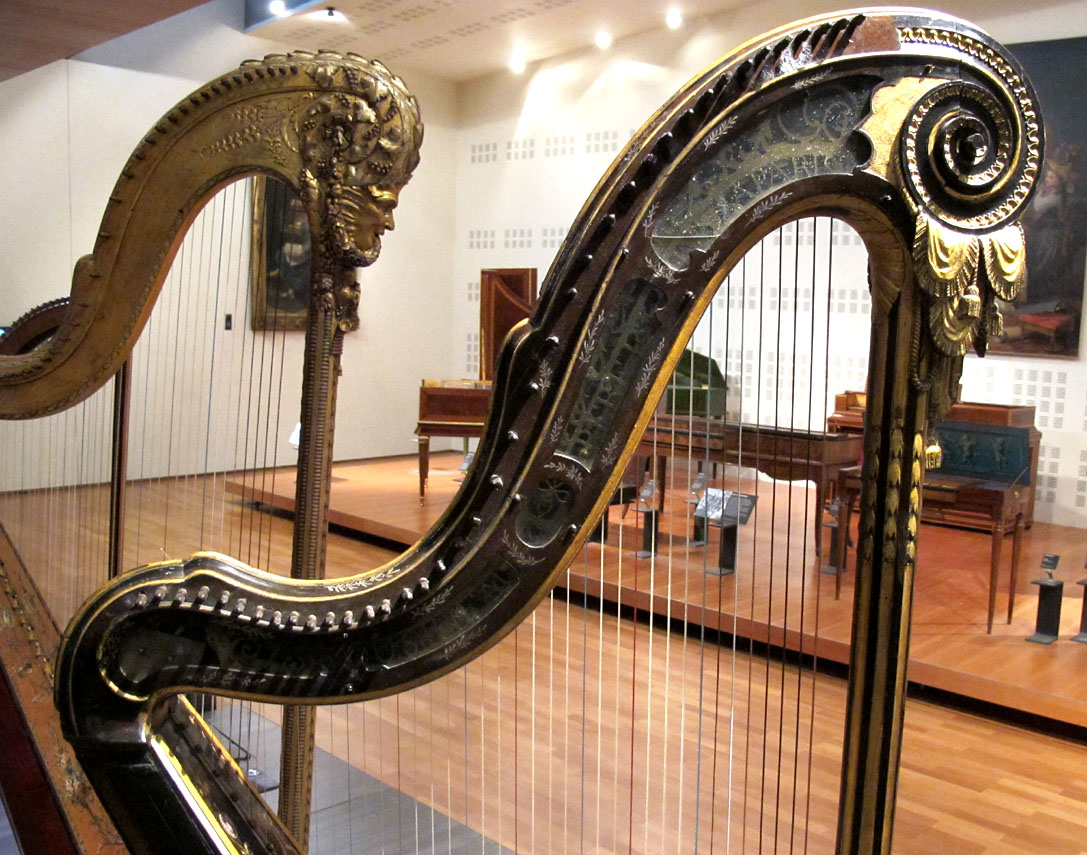
…along with some of the more interesting details of heads and bases. I love the see-through glass windows allowing the mechanics to peek through on this 18th century Cousineau.

An amazing face on the head of a 1787 Naderman
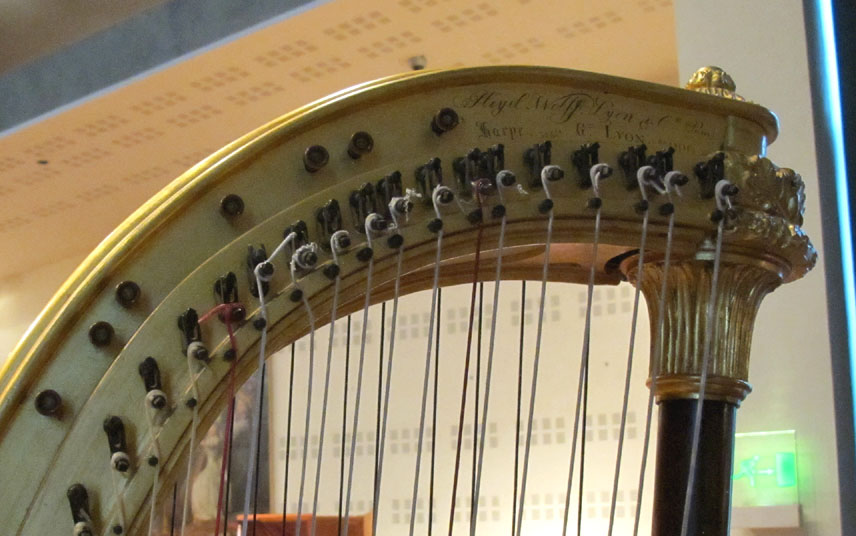
Another Pleyel chromatic harp. I had seen this model once before at a private dealer’s home. These 7 buttons are designed to sound 7 individual bells (one for each natural note) hidden in the upper neck, simply as a tuning reference.
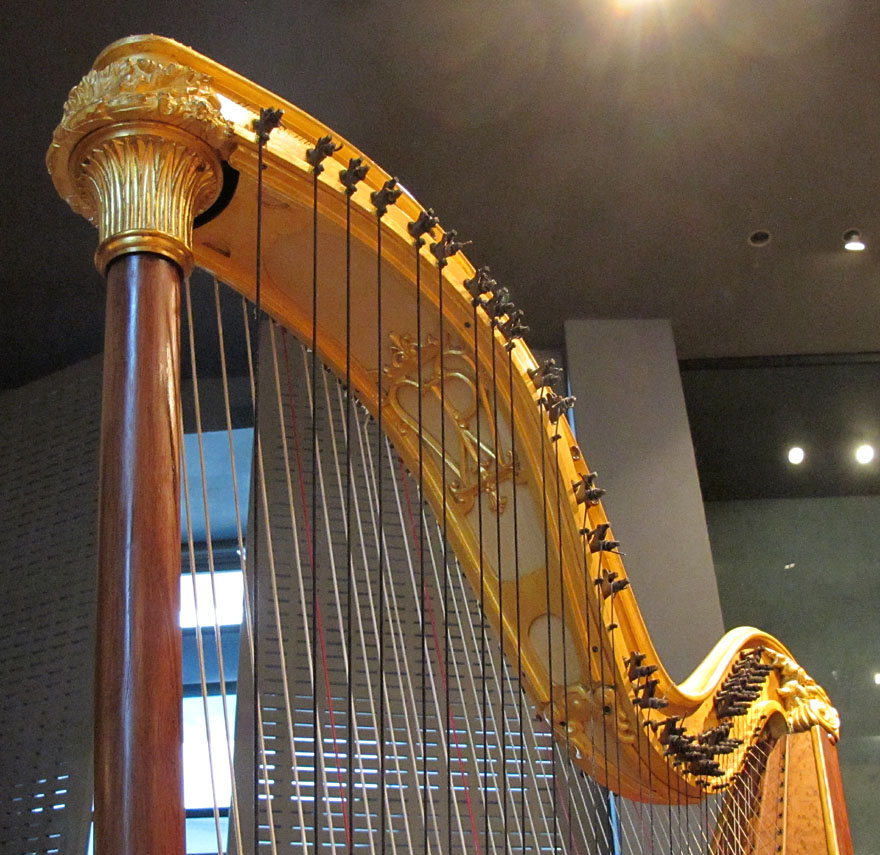
The underside of this neck has fabric-covered openings to let out the sound.
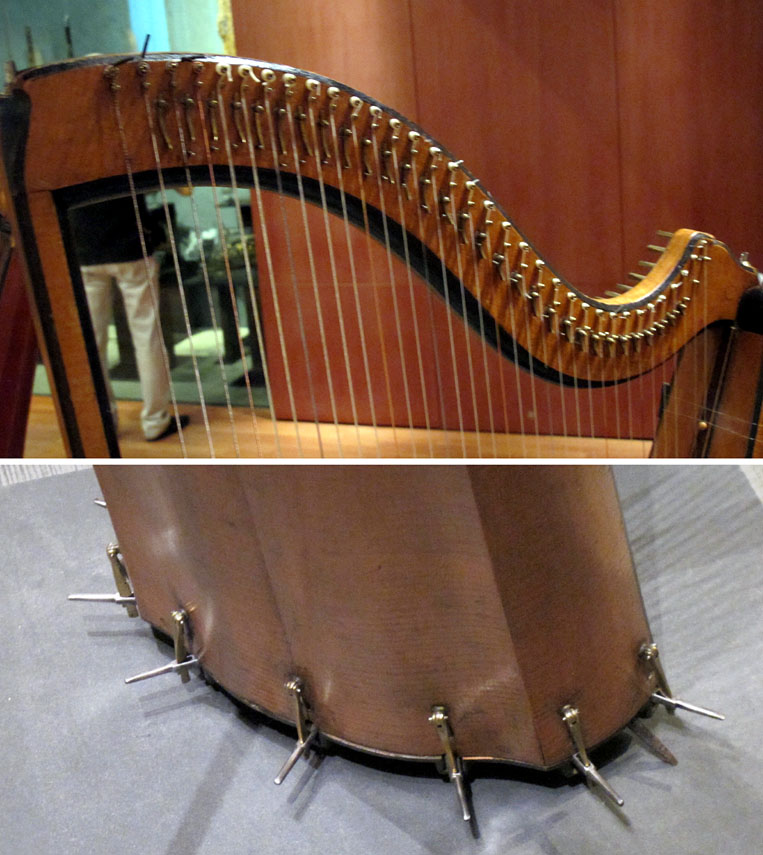
This is a fascinating early (1728) single-action German harp by Jacob Hochbrucker…interesting primitive pedals and sharping mechanics…not sure how it would work!

And this Naderman has too many…8 instead of the normal 7 (1 for each diatonic note), plus an extra one above for the “door swell” I’m guessing.
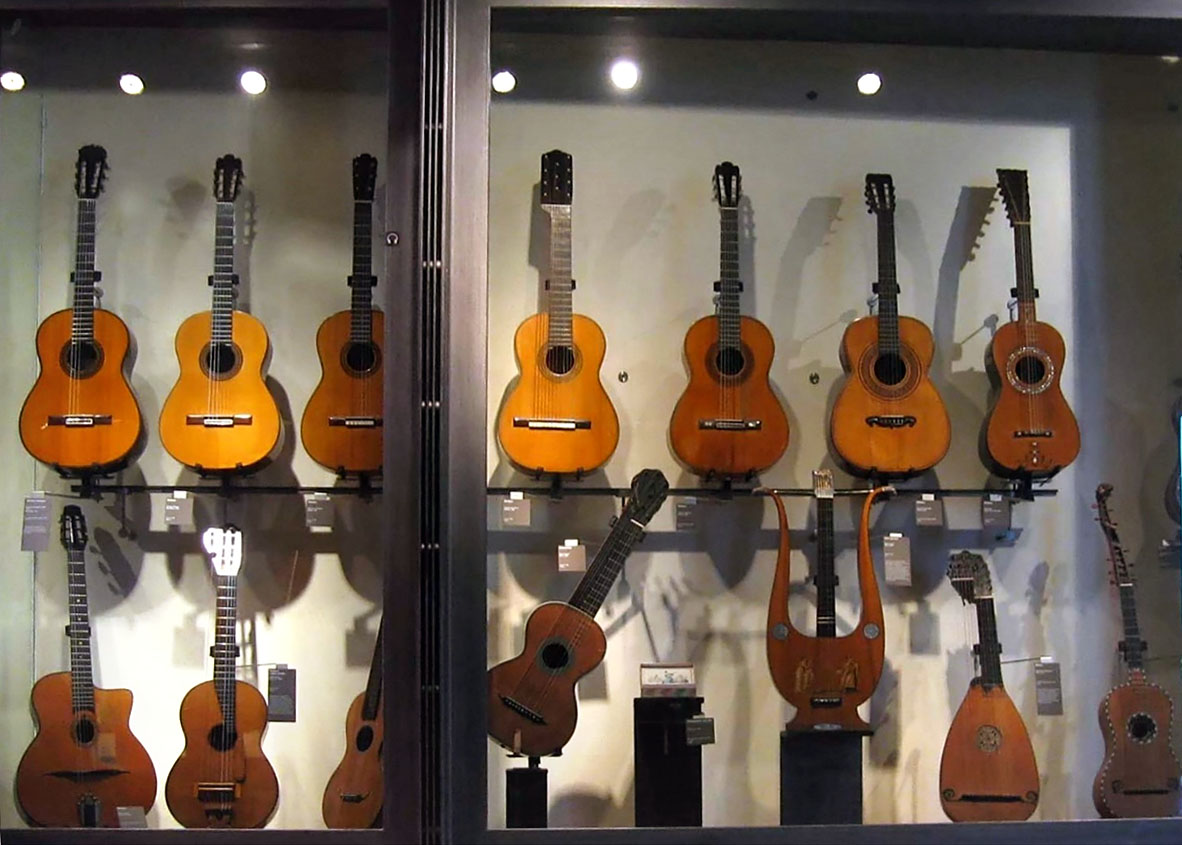
I wish this was my photo, but it’s not. Sadly, I was expecting more harp guitars on display as in this shot. This photo (from Wikipedia) shows the same case that a previous visitor shot sometime in the past; it includes at least three additional harp-guitars: the c.1760 theorboed guitar, a Lacote decacorde, and the 11-string Torres.
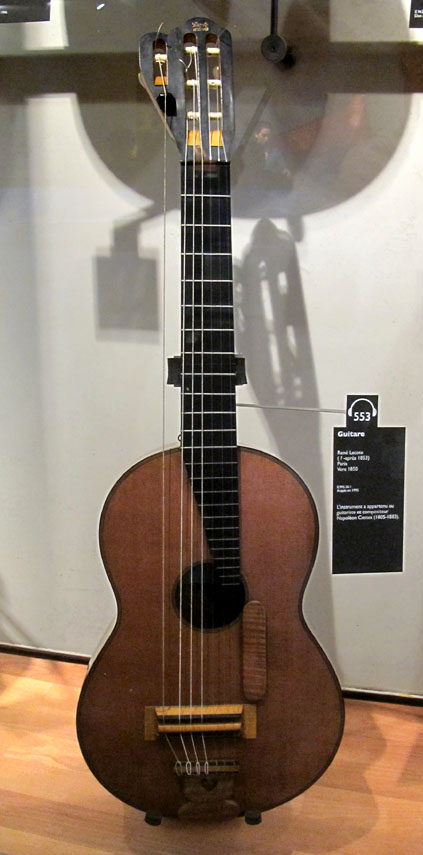
These were missing, but I did see a Coste-modified Lacote…

…and a killer top-of-the-line harpolyre
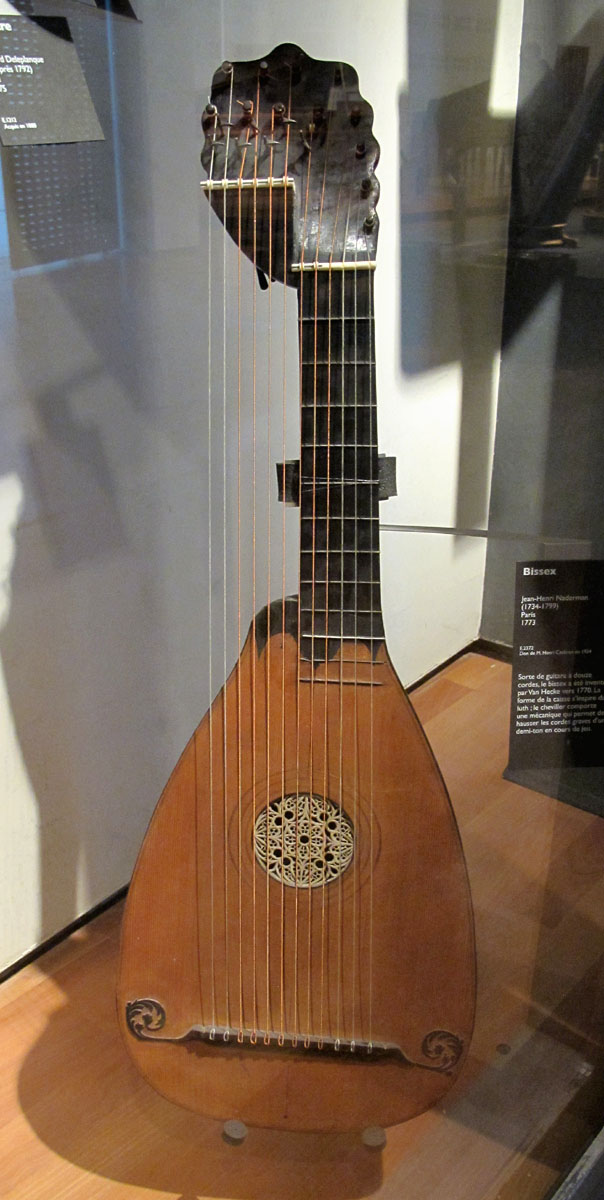
Best of all, I finally got to see the Bissex! This unique invention (which appears on my site in this “Relatives” Gallery) surprised me with its small size; for some reason, I expected something much larger. Actually, the scale length is pretty much standard guitar, but the bridge has been moved way down on the soundboard.
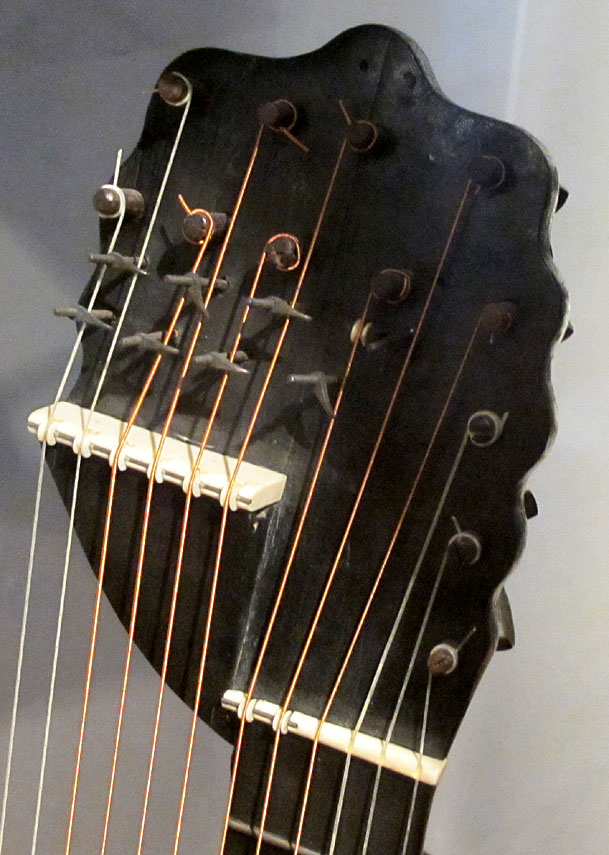
The intricate and spiky sharping levers. Strangely, the fourth string also has a sharping lever. Remember that this instrument uses the then-common 5-course guitar tuning for the neck. The 6th string – even though on the neck – is the beginning of the sub-basses (G). So, we expect to see a sharper there…but why on the fretted A?
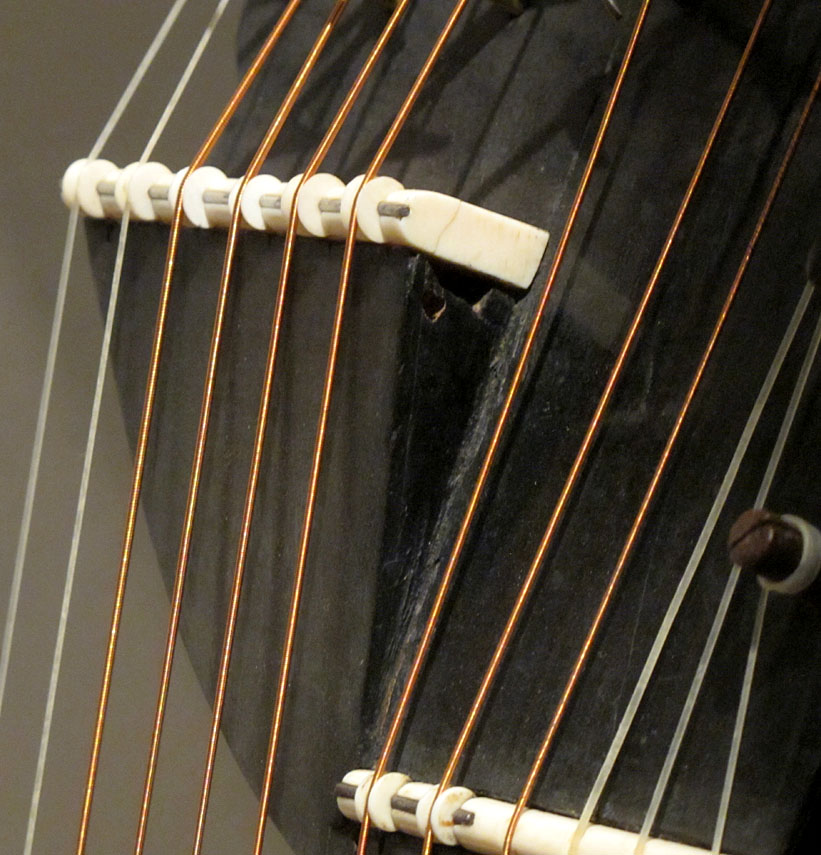
I love the elaborate ivory guides for the wound strings to ride on during their pitch shifts.
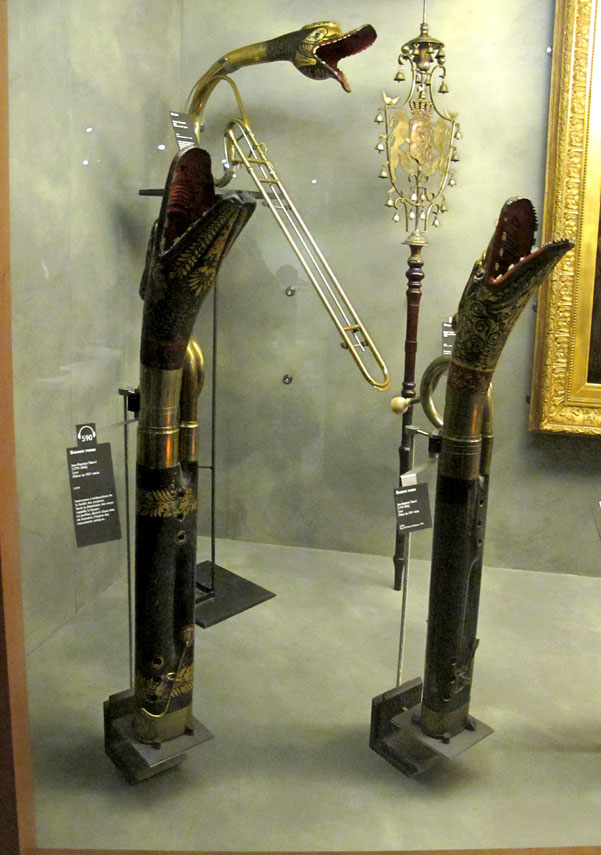
I’m now in the 3rd level/section, where the first thing to greet visitors is a case of marvelous bassoons and horns with zoomorphic heads for their bells.
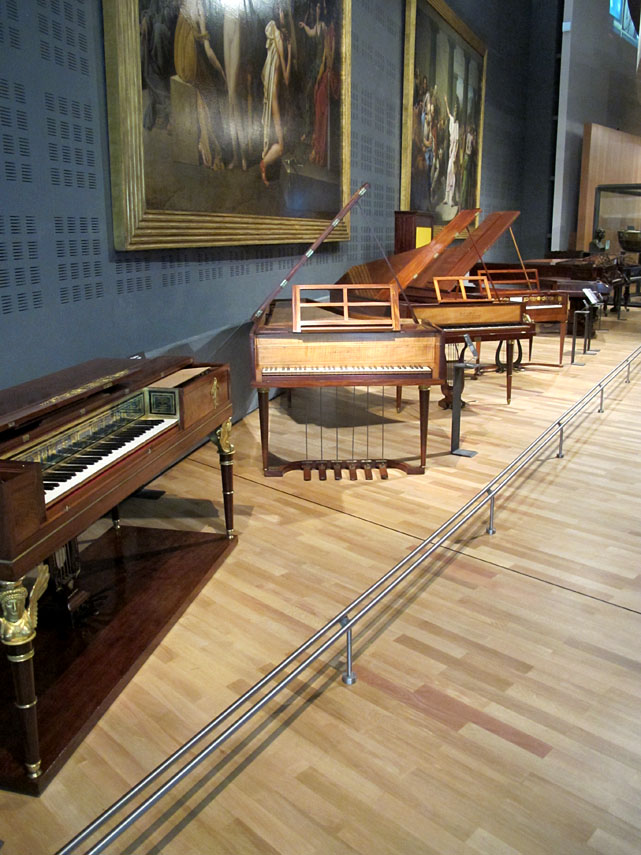
Then another long keyboard hall
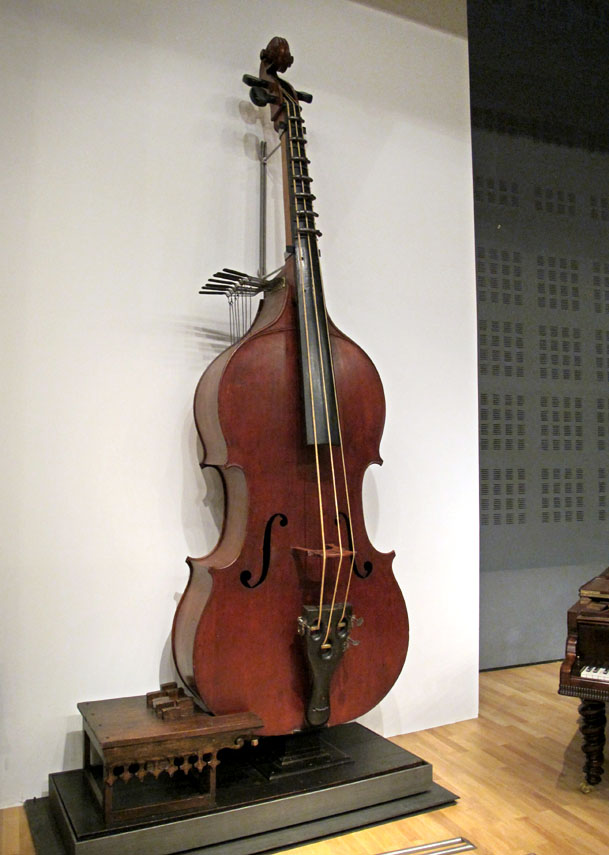
Look carefully at this instrument and also compare it to the piano just visible on its right. Yes, this is the amazing Octobass, of which I believe only one original was ever built (by Vuillaume in Paris, c.1850). It’s almost eleven and a half feet tall. A modern recreation (or 2?) was also built – we saw one (and heard it played by my friend Matt Hill at the Phoenix museum) three years ago. Like the Eiffel tower, something that has to be seen up close in person.
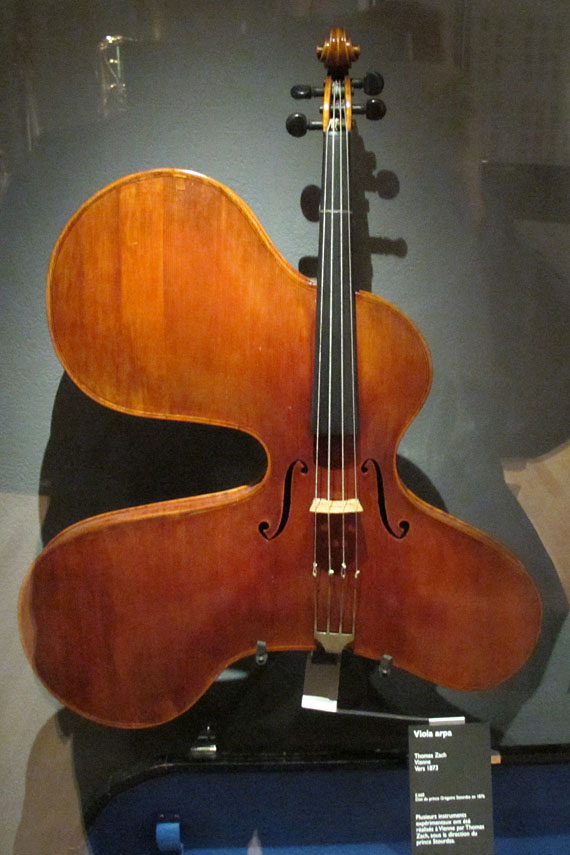
Quick quiz: This viola was:
A) run over by Les Cars Rouges, B) dropped from the Eiffel Tower, or C) melted in the heatwave of 2003.
Answer: None of the above; it was built like this on purpose.
I’d seen this goofy viola in some book previously, but noted that they are here calling it a “viola arpa” – possibly because the air capacity from the excessive growths was meant to make it sound better (more “harp-like”?).
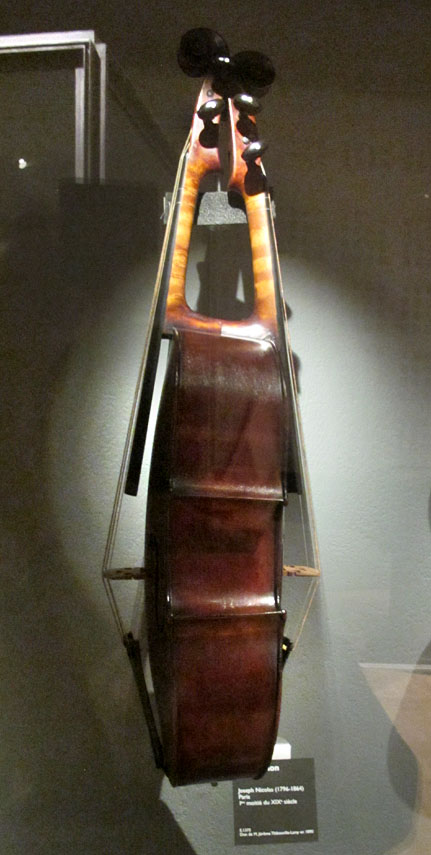
Next to it was a similarly impractical double-sided violin/viola
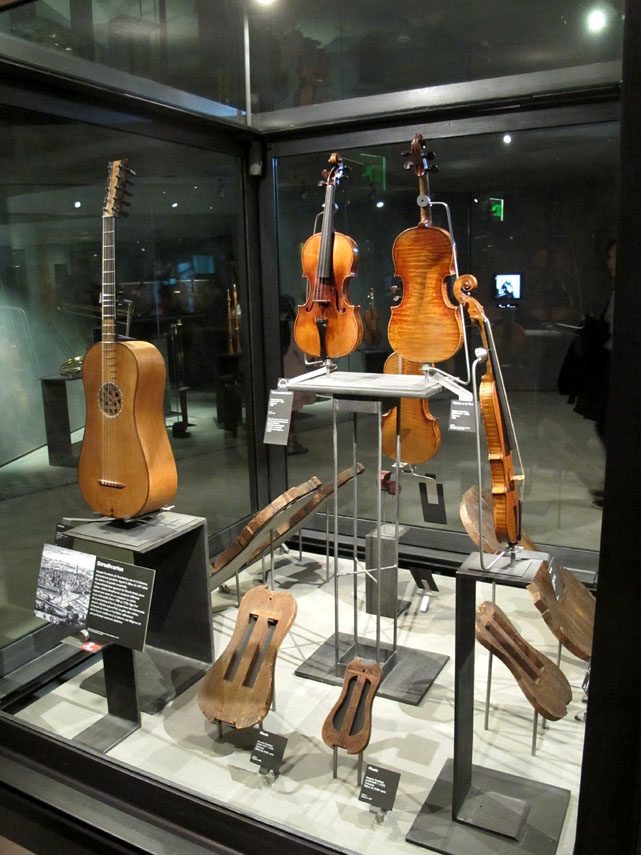
Every instrument in this solitary case is a Stradivarius
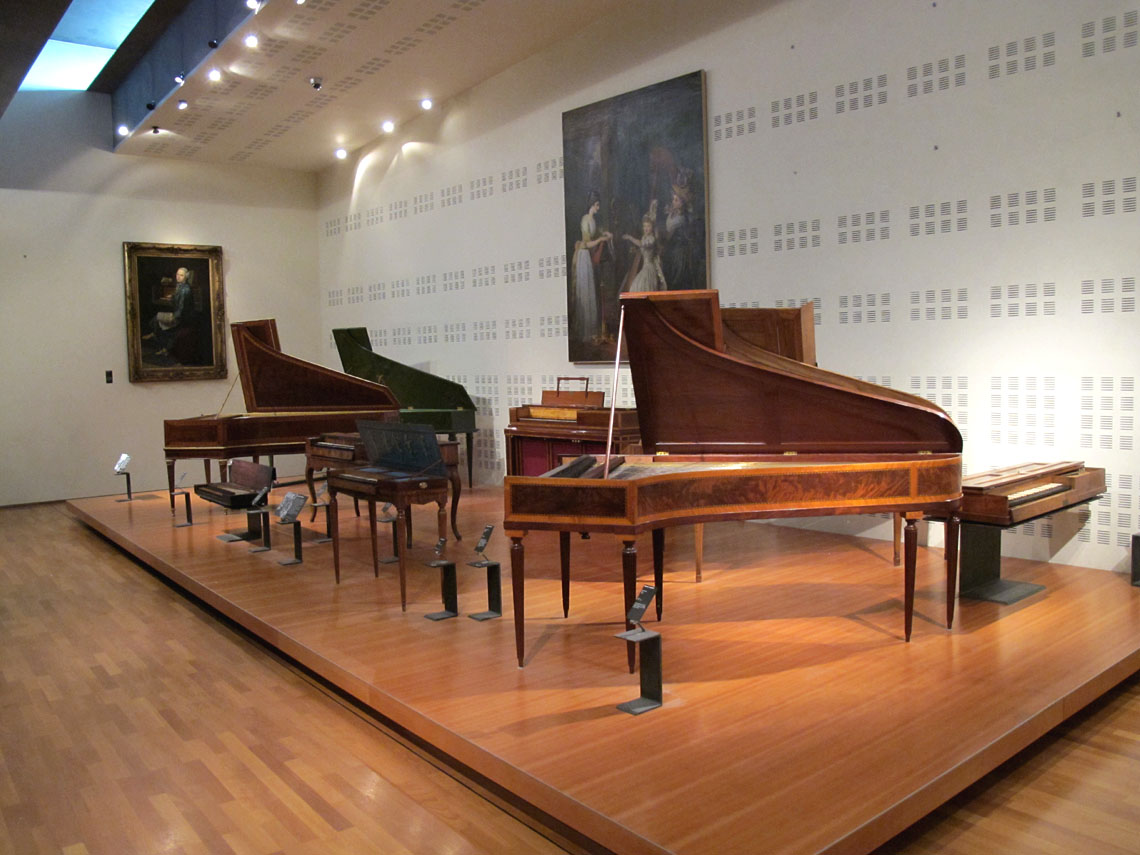
And another keyboard group (each display from a different century, as one winds their way upwards and generally forward in time).
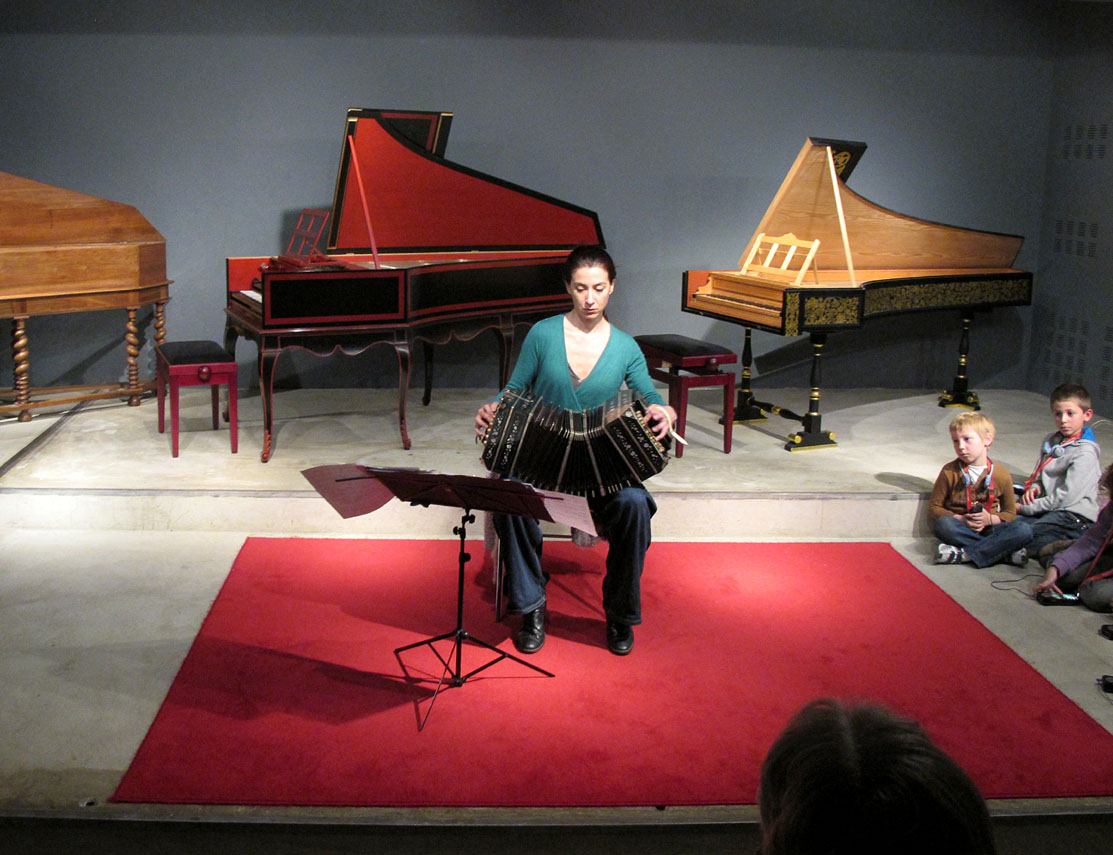
At the very top level were modern 20th-century inventions and multimedia. On the way back (taking as much time as I had coming), I stopped to enjoy a button accordionist (with a billion-button version) performing everything from Satie to Edith Piaf to Tango.
As tends to happen in these places, I get beyond overloaded (as in “overdose,” as this stuff is my drug). I always wish I could spend smaller bits of time throughout several days to absorb it all. I was able to do that at the Phoenix Music Museum, and also the Met to some extent, and it makes all the difference. (Not that I’m inviting visitors to the Miner Museum to spend the week…!)

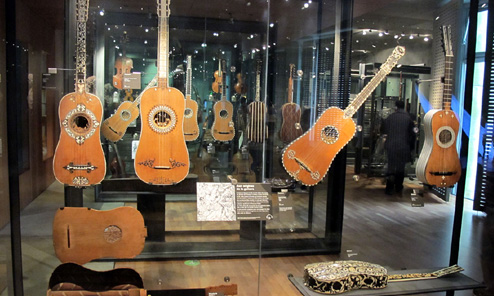
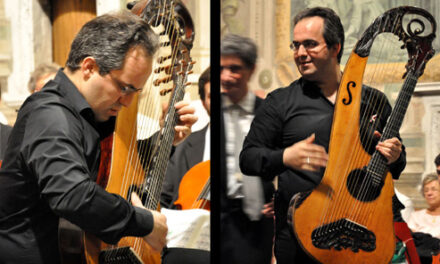
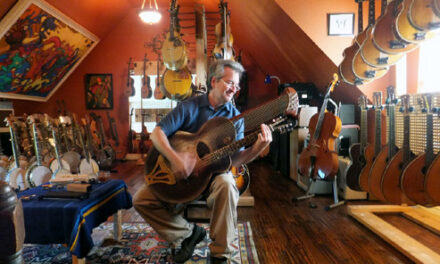
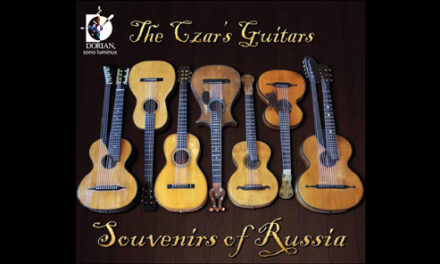
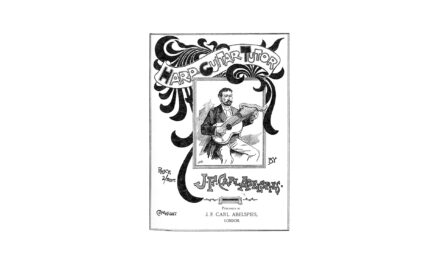
Re the Naderman harp with the extra pedals…. the 8th pedal operates the doors in the back of the box that act as a swell. the 9th pedal moves a cloth mute against the strings to make it play pizzicato
Re the Naderman… it actually has 9 pedals… the 8th operates doors in the back, that act like venetian swell on a harpsichord.. the 9th , whch runs across the board, operates a fabric mute that makes the harp play etouffes… There is one like it in the V&A…